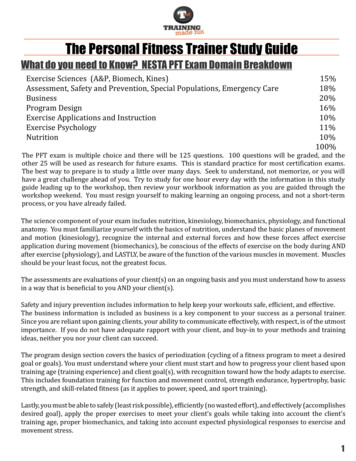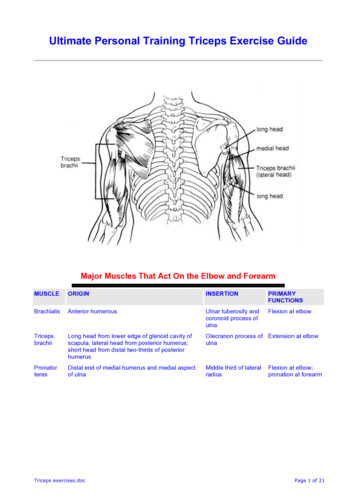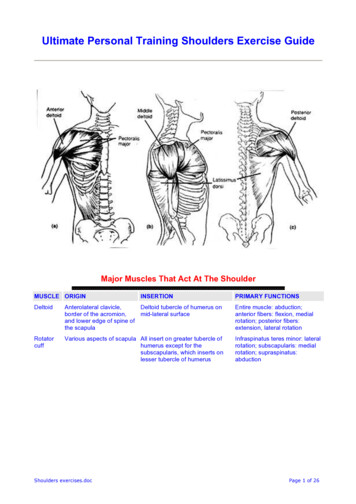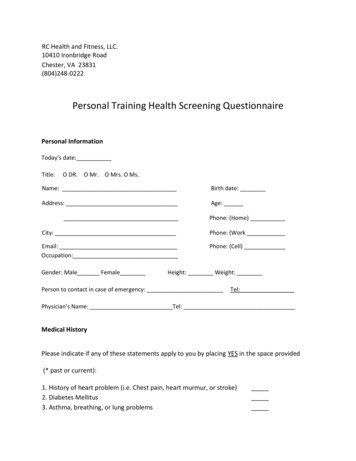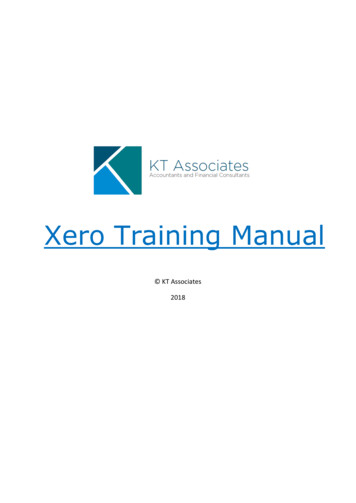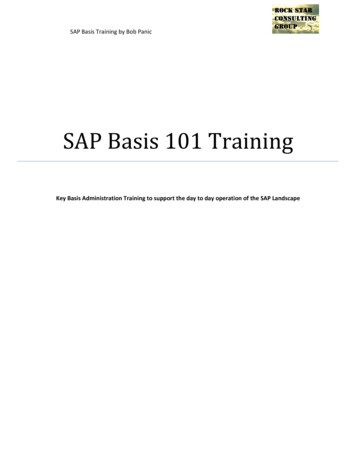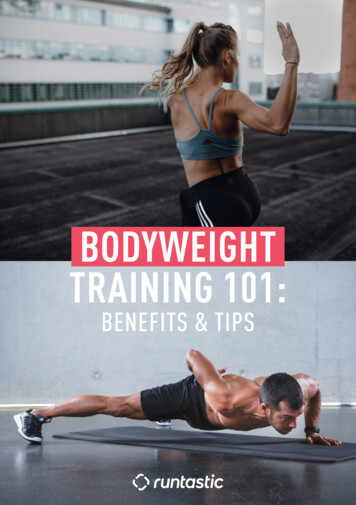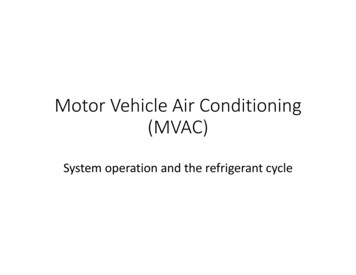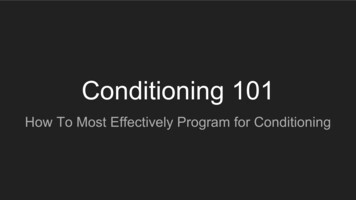
Transcription
Conditioning 101How To Most Effectively Program for Conditioning
Which Athlete Has a Higher Level of Conditioning?Floyd MayweatherAaron Rodgers
What Is Conditioning?Conditioning is a measure of how well an athlete is able to meet the energyproduction demands of their sport. -Joel JamiesonATP- Adenosine TriphosphateIn the most simple terms:Good Conditioning Your body develops ATP as fast and for as long in durationas the sport or activity requires.Bad Conditioning It doesn't .
Think of Your Body As a Car- 4 body systems need to be trained specifically and they all must work closelytogether to operate as efficiently as possible.- Training these systems to be a cohesive unit results in an increase in biologicalpower, the base of conditioning.These systems are:-Neuromuscular- The muscles of the body and the nerves that supply them-Cardiovascular- Circulates blood through the body including the heart, blood vessels, etc.-Hormonal (Endocrine)- Regulates the activities of the cells and organs throughout the body-Metabolic- Converts the food we eat into energy the body can use
Energy Systems*Notice how all of the systems overlap*Every system has a POWER (how much energy can the system produce) and CAPACITY (how long canthe energy system supply that energy) component
Aerobic Energy System- Long term energy system used in times of long exercise at low intensities being either continuous orinterval (cross country, tempo running)-The only system that can utilize and break down fats to form ATP; Fats provide more energy than sugarsat 9 calories per gram instead of 4 calories per gram.-The Aerobic system also has a large influence on anaerobic processes (to be covered later)-An athlete may increase Aerobic power by increasing their Anaerobic threshold (This threshold, usuallycharacterized by a specific heart rate, is the limit of your aerobic energy production). The higher thethreshold, the higher the aerobic power.-Aerobic Capacity relies on numerous factors including but not limited to; Blood flow to the working muscle(s), Oxygen uptake of the working muscle(s), substrate/sugar stores (think of this as your body’s gas tank)
Aerobic Energy System Training-Cardiac Output-The amount of blood the heart pumps through the circulatorysystem in one minute of time.-To improve the cardiac output we need to look into the factors that influence it;Stroke Volume (SV) & Heart Rate (HR).-In order to increase SV (the amount of blood pumped by the left ventricle in onecontraction) we need to increase the size of that left ventricle. This is done withlong long and slow training labeled by the cardiac output method
Aerobic Energy System Training- Cardiac Output Method-Train with a consistent HR around 120-150 bpm-1-3 times/week for 45-90 mins/session; increasing in volume over time.-Activities such as biking, jogging, swimming, jumping rope, LIGHT medicine ball work, sport specific technique drillsetc.To complement the Cardiac Output method, this training template (among others) can be used-Tempo Method- Increase oxygen utilization of working muscles (Slow Twitch) by causing local hypoxia (oxygen deficiency)to the working muscles.-Train with 2 second concentric/eccentric actions per rep (no pauses); 3-5 sets of 8-10 reps of 3-4 exercises perworkout.
Anaerobic Lactic (Glycolytic) System- Responsible for moderate bursts of activity in duration at high intensities (400 meter sprint, wingate test)- Glycolysis- The breakdown of glucose by enzymes producing energy (2)(ATP) and pyruvate(2)- In times of aerobic activity the pyruvate is placed into the krebs cycle and glycolysis begins. When oxygen is notreadily available the pyruvate is converted to lactate and anaerobic processes take over. *this process can be reversed*- During Anaerobic Lactic activity the anaerobic processes pair with hydrogen ion production. The accumulation of hydrogenions is believed to be the cause of the muscle “burning” sensation.- The aerobic system and processes are responsible for clearing lactate in times of anaerobic activity, the more lactate leftsitting around the more fatigued an athlete becomes. (This is why aerobic training is important for even the most anaerobicalactic sport athletes)
Anaerobic Lactic (Glycolytic) System Training-Cardiac Power Intervals- Increase cardiac tissue contractility (how forcefully the left ventricle can contract). (Jaimeson)-Train at maximal HR for 60-120 seconds with 2-5 minutes of recovery between intervals at 120-130 bpm. 4-12 reps/session in1-2 sessions/week.LACTIC POWER- Lactic Power Intervals (Jaimeson)- Train with explosive exercises for 20-40 seconds with full recovery between bouts, perform for 3-4 rounds.- Resistance Training Drop setsLACTIC CAPACITY- Lactic Capacity Intervals (Jaimeson)- Train at maximal intensities for 90-120 seconds with 1-2 minutes rest for 3 rounds (complete exhaustion)
Anaerobic Alactic (ATP-PC) System- Adenosine Triphosphate - Phosphocreatine or Creatine Phosphate (CP)- Short bursts of activity at very high intensities (10-15 seconds)- The ATP-PC system is the initial fuel for exercise- ATP and PC are used as the main source of energy and run for about 10-15 seconds (but never fullyexhaust) before being taken over by lactic processes.- Both ATP and PC are replenished by aerobic processes* (again this is why even the most alacticathletes need to train aerobically)- Short Sprints, Jumps, Max Lifts, ETC.
ATP-PC System TrainingALACTIC POWER- Max Effort Sprints/ Jumps/ Strength Training with full recovery (Improves rate of ATP regeneration by the alactic system)- Sprinting- 45 seconds to 1 minute of rest for every 10 meters covered- Jumping- Cover as much distance or jump as high as possible- Strength Training- Usually around 80% of compound lifts (increases maximal muscle fiber recruitment)ALACTIC CAPACITY- Alactic Capacity Intervals (Jamieson) (Aims to increase PC stores)-Train maximally for 8-15 seconds with 20-90 seconds of rest, that is one rep. Each workout should have 10-12 repsper set and 3 sets per workout. Add 8-10 minutes of active rest between exercises, 1-2 sessions/week. Each week increasethe work interval and decrease the rest interval. Start with 8-10 seconds of work with 60 seconds of rest and slowlyprogress to 12-14 seconds of work and 30 seconds of rest. Exercises include, squat/ split squat jumps or explosivepushups/ bench press.
What Is Conditioning? Conditioning is a measure of how well an athlete is able to meet the energy production demands of their sport. -Joel Jamieson ATP- Adenosine Triphosphate In the most simple terms: Good Conditioning Your body develops ATP as fast and for as long in duration as the sport or activity requires. Bad Conditioning It doesn't .


